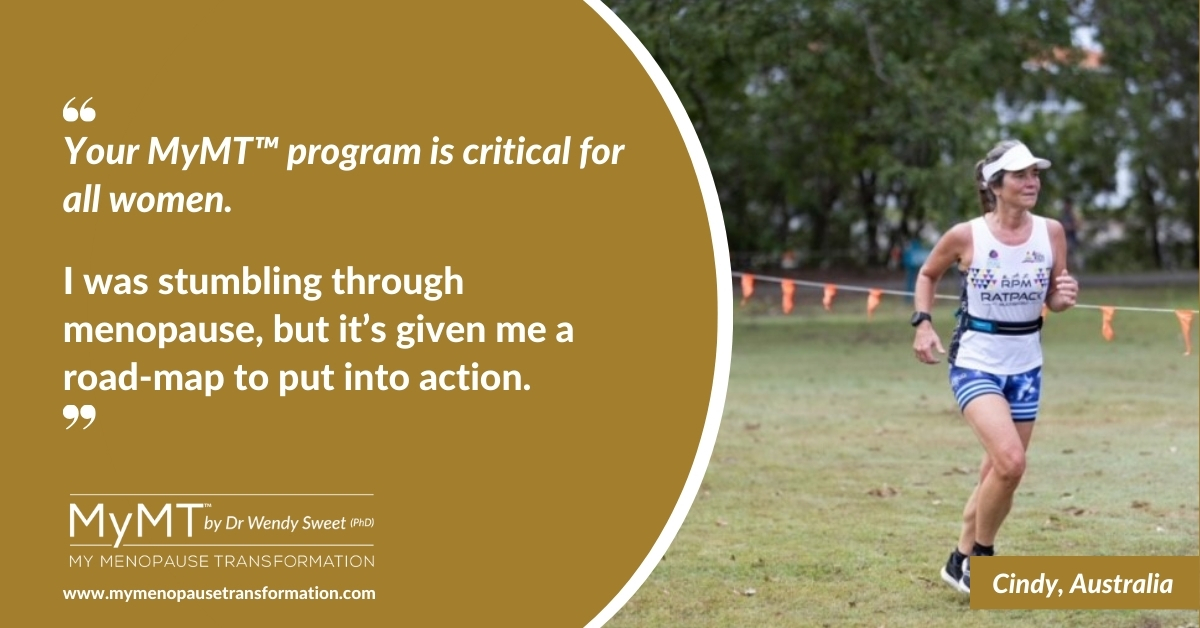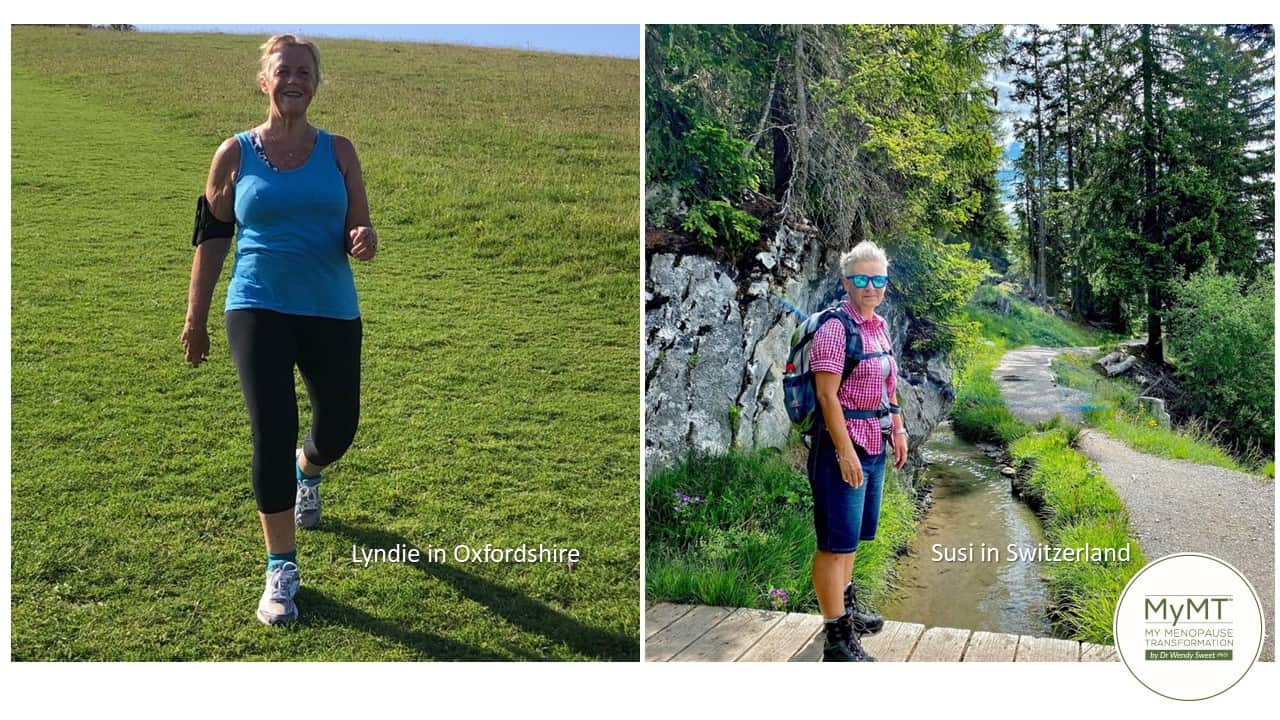When both Lyndie and Susi (in the photos above) came into my menopause transformation programmes, they were hardly walking anywhere.
However, they both experienced fatigue, sore joints, lack of motivation and for Lyndie, her breast cancer treatments left her exhausted. They were also confused about what type of exercise was best for them. But as they moved through the programme, they began to walk more.
Lyndie would get up in the morning and stride out over the hills there in Oxfordshire and Susi, found her way through the snowy trails in a Swiss winter and then as summer approached, she went out hiking.
I was so proud of what they achieved with their walking and hiking, because initially, they weren’t walking much at all. It’s what I encourage women on my programmes to do more of and I encourage you to as well.
There have been hundreds of photos posted in my private coaching group over the years and I love my ‘virtual travelling’ around the world as women share where they are walking.
New Zealand’s South Island, the Peak District in the UK, Moose crossing the road in Canada and an Australian beach – all beautiful locations for MyMT™ women who are out walking. Whilst many continue to go to the gym, I also encourage them to walk outside, especially if they work indoors in artificial lighting.
They need the benefit of natural light in their eyes to help restore their circadian rhythm … and they need to walk for their stress relief and to help their sore, aching knee joints. When they have knee joint problems, I encourage them to buy hiking poles and walk using these for balance and support.
I call ‘walking for our health‘, the forgotten factor in our menopause and post-menopause symptoms management and in this article I explain why!
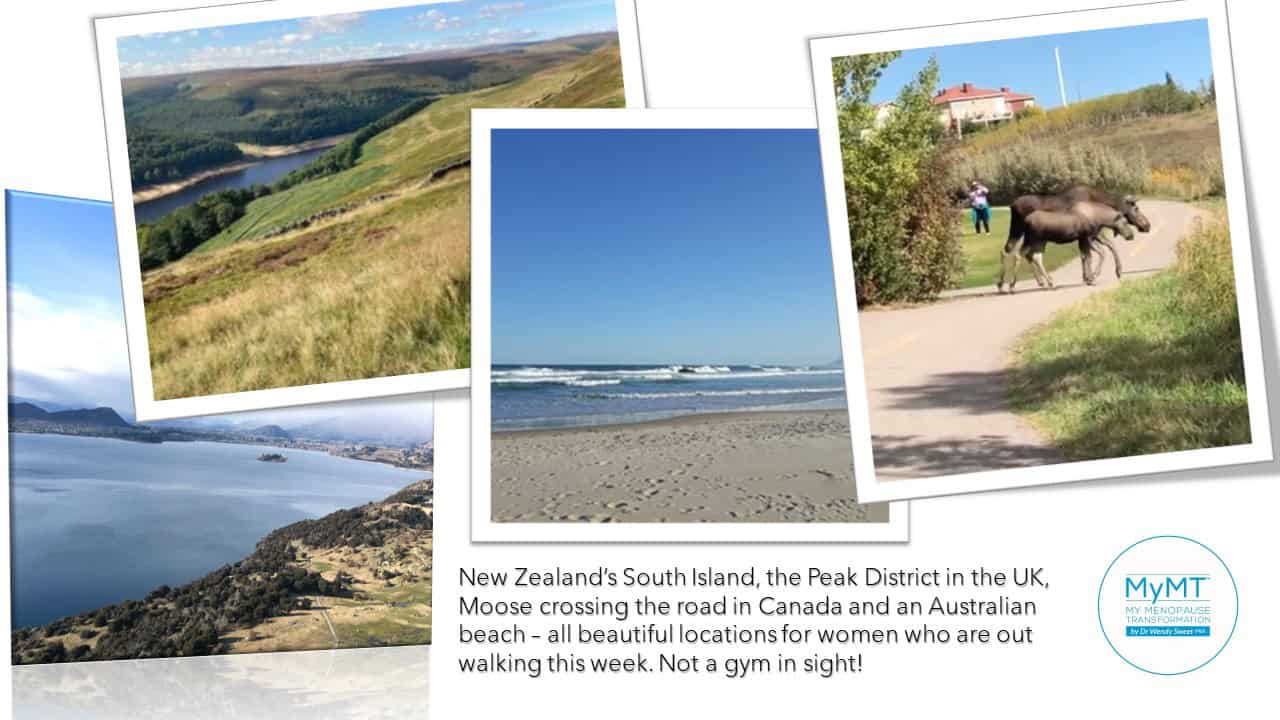
Walking is our (menopause) medicine.
Walking for 2.5 hours a week—that’s just 21 minutes a day—can cut your risk of heart disease by 30%. In addition, this do-anywhere, no-equipment-required activity has also been shown to reduce the risk of diabetes and cancer, lower your blood pressure and cholesterol, keep you mentally sharp and improve your knee joints. Even a quick one-minute jaunt pays off.
I learnt all this from reading The Harvard Nurses’ Health Study, which has been tracking the health behaviours of more than 200,000 women for over three decades.
This study has shown that moderate walking for an average of only 30 minutes a day can lower our risk of heart disease, stroke, and diabetes by 30% to 40%, and the risk of breast cancer by 20% to 30%.
Walking also helps your mood.
A number of studies have found that it’s as effective as drugs for decreasing depression, because your mood-elevating endorphin levels increase both during and after the walk.
It’s an activity that can also relieve everyday stresses too. And many people find that walking helps clear the mind—you may even find the solution to a problem that’s been bugging you.
Depression and anxiety disorders consistently feature in menopause symptoms and according to Australian Psychologist, Professor Felice Jacka, depression prevalence globally accounts for 40% of the global burden of disease. Women in menopause are no exception.
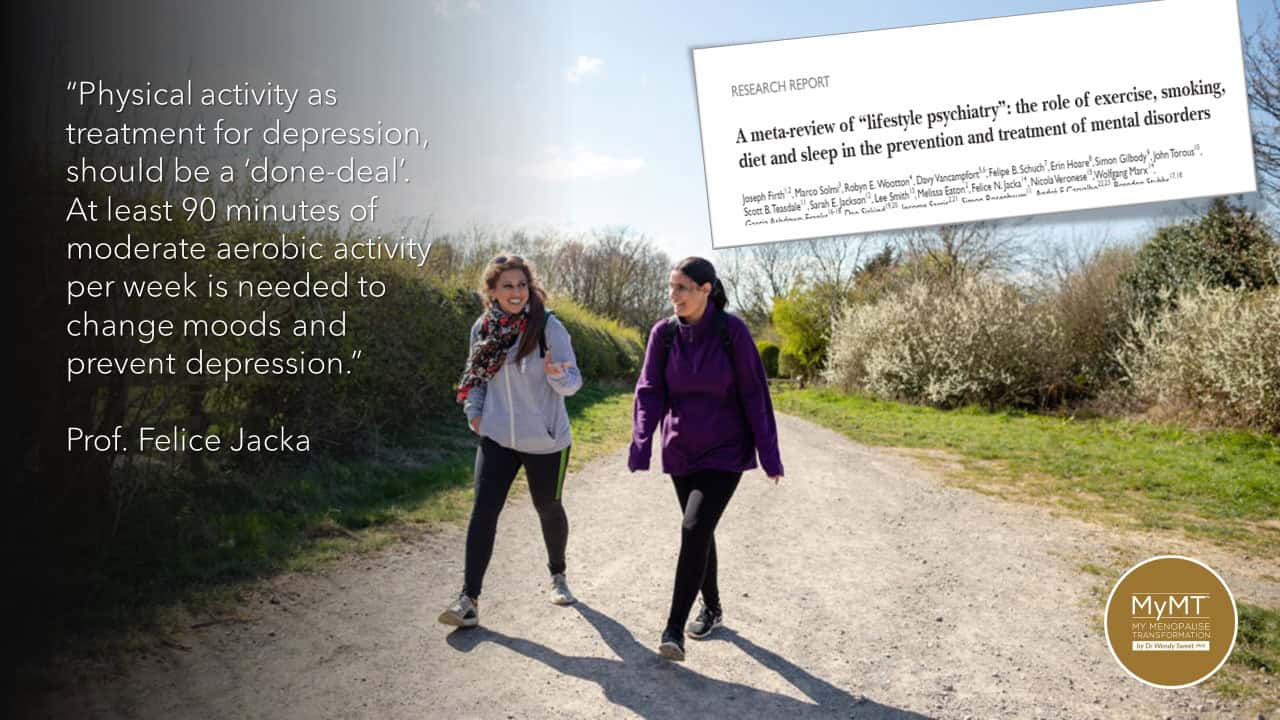
Walking is a closed-kinetic chain exercise which means that there is a co-contraction of the quadriceps, hamstrings, hip flexors, soleus, and gastrocnemius (calf) muscles, involved in the movements.
Not only does walking promote weight bearing and early mobilization in a knee rehabilitation programme, but in numerous studies on osteoarthritis (OA), walking is a first-line non-pharmacological intervention for management of OA knee symptoms.
It is now recognised in international guidelines for osteoarthritis management and the minimum is 10 minutes a day. [Jakiela et al., 2021]
With so many benefits of walking, this begs the question – Why aren’t we all walking more as we move through menopause and into post-menopause?
Based on physical activity participation studies as well as the results from over 500,000 women who have undertaken my symptoms quiz for menopause over the past decade, it seems that … tired women do not exercise.
The consistent themes in the literature on physical activity and exercise indicate the following challenges that women experience:
- Lack of time.
- Lack of motivation.
- Lack of energy.
- Injuries and sore legs, ankles, feet and hips.
Numerous sport and exercise psychology studies have linked all of these factors to women’s lack of exercise and physical activity over the past three decades. I wonder which factors you relate to?
But there’s a bit more to the conundrum of non-participation in physical activity for women as well.
Feeling socially isolated and talking to Physicians who didn’t understand the severity of their symptoms and the change that arrived to their quality of life, were comments made by women in a new study out of beautiful Edmonton in Canada.
“Tired women will not walk” mentioned one participant, whilst another said, “We walk and talk. It’s something to achieve, you know, to look forward to, with others experiencing the same symptoms.”
Reading this study bought back memories of the women I interviewed for my doctoral studies – “You know, I love exercise, but I’m too tired all the time now that I’m in my 50s” said one participant.
“I’m so confused about why I get injured all the time when I’ve been doing the same exercise for years” lamented another. (Sweet, 2018).
Menopause and midlife are stages in a woman’s life that can be marked by debilitating symptoms that impact quality of life, as well as being a vulnerable time for health changes.
Whilst the primary treatment emphasis is on hormone medications and supplements, exercise, especially walking, remains a simple solution that has wide-ranging health benefits.
Unfortunately however, too much emphasis is often given to different modes of exercise that may be high impact and high intensity. There is also emphasis on doing heavy resistance training for bone health … and as I’ve found, heavy lifting when women aren’t sleeping, is to the detriment of joint and cardiovascular health.
For many women, high-intensity activities are exhausting, especially if they aren’t sleeping. High impact exercise may also cause injuries in knees, feet and muscles, at a time when the muscle structure and the blood vessels are changing as they adapt to declining oestrogen and progesterone.
Whilst part of the solution to injury management for the knee is to stimulate the foot, the other solution is to change up your exercise interventions so that you do more walking …. preferably outside in nature.
You should also try some barefoot walking. The foot is crucial for providing traction for movement and leverage for propulsion. Walking barefoot for at least 15-20 minutes daily, also aids in balance and falls protection as we age.
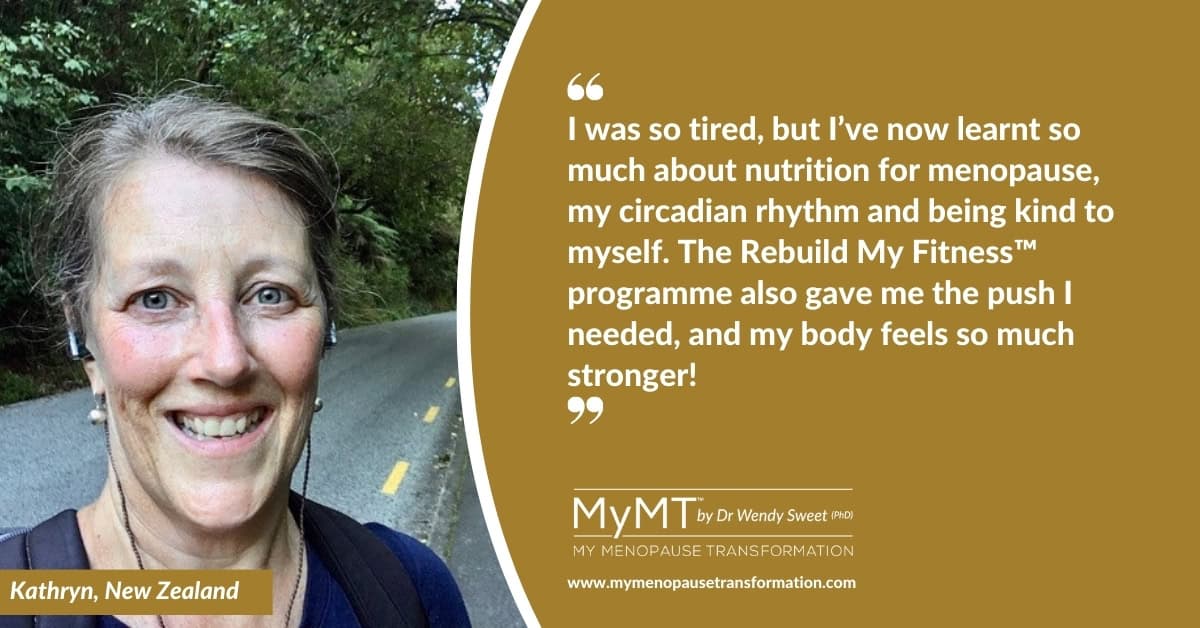
Since the running revolution in the 1980s which many of us have enjoyed for years, there has been an emphasis by running coaches on how to run and from that perspective, how to walk has been forgotten.
When I reflect back on my life in the exercise industry and with all the activities I’ve done, there hasn’t been once, whereby ‘how to walk’ has been a practice that I’ve been involved in.
Sure, I studied gait analysis from a biomechanical perspective, which was very technical, but during all the years of teaching aerobics and being a PT myself, I never taught anyone how to walk properly. Nor did I think about the fact that I might not be walking properly myself …. especially when it came to grounding the big toe on walking and increasing the stride length.
A remarkable 2017 study from Deakin University in Australia also found that both running and brisk walking strengthen our intervertebral discs as well as hydrates them.
When discs are hydrated, this helps them absorb pressure and impact and the advantages were particularly noticeable in the lower lumbar region – I’m sure that many of us have had lower back problems as we’ve approached menopause and I had this problem myself.
I never thought that lengthening my stride and pushing off my big toe and ‘grounding’ it against the earth, was part of the solution to my lower back pain. But it was, and still is.
When we walk, we need to lengthen our stride and extend our back leg, pushing the front of the foot into the ground.
If we take SHORT strides, then this tightens our pelvis and lower spine, leading to more fascial tightness (the fascia surround your muscles and are important for hydration and function as well as nerve transmission).
When you (re) learn to walk well, then you can also change-up your pace a bit too. Dementia research suggests that the pace of walking is another consideration for women as they age. Decline in gait speed and cognition has been found to be associated with increased dementia risk in a variety of studies. [Collyer et al, 2022].
In a world where everybody is fixated with counting the number of steps they do each day, this to me, encourages faster walking and shortened stride length, which doesn’t help our fascia function, nor does it necessarily help with gluteal and hamstring strength. Hence, don’t just focus on number of steps but your stride length too.
Stride length is measured from heel to heel and determines how far you walk with each step.
According to studies undertaken at Arizona State University Extension, a woman’s average stride length is 2.2 feet, or 26.4 inches or 67 cm. And yes, your height matters. In general, people with longer legs have a greater stride length than those with shorter legs.
So, my message to you as we focus on joint health, throughout the month of April, is to have a renewed focus on WALKING.
Not only will it help your mood, but your balance as well. As such, in order to walk-well, and maintain an optimal gait you need to STIMULATE your gait. You need to tap into all the fascial systems with each step you take – a process that can only be achieved with a stride length that is long enough.
To get you started, I’ve found this short 2 minute video from another passionate walking advocate, Joanna Hall, who is creator of the UK’s Walkactive programme.
And the first simple change that she suggests to make to your walking technique?
Make sure you are pushing your foot into the ground and lengthening your stride. She calls this an ‘active foot’ and an ‘open ankle’. It’s only a couple of minutes long, so have a listen before stepping out for your next walk.
Don’t be intimidated by 10,000 steps – less than this is OK too.
Physical activity participation research continues to show a decline in physical activity for women over the age of 50 years who are the highest cohort (along with adolescence girls) to drop out of regular physical activity. With our exhaustion and being time-poor, I’m not surprised.
Professor Wendy Brown and her team have been studying this for over 30 years in Australia. And here’s the thing – I can attest to this as well.
When I wasn’t sleeping and had sore joints and muscles, felt dizzy and my weight was increasing daily, the last thing I felt like doing was my beloved exercise – especially with the emphasis on boot camps, high intensity workouts and a ‘go-hard, or go-home’ training mantra.
That’s why I wish I had also known about Professor Min-Lee’s work at the time, becuase it helps us to understand that we don’t necessarily need to feel pressured by walking 10,000 steps every day – you can do less.
The 10,000 steps protocol originated back in 1965 when a Japanese company made a device called Manpo-kei. The translated to ’10,000 steps meter’ and it was intended as a marketing tool. So began the notion of needing to achieve 10,000 steps in our health consciousness.
Because Professor Min-Lee had already been studying the relationship between physical activity and health in older women, she took her 10,000 steps curiosity to this demographic too. I’m so pleased that she did. The research looked at over 16,000 women aged between 62 years to 101 years and for 4 years between 2011 and 2015, all participants wore tracking devices during waking hours.
The researchers wanted to explore whether increased steps were associated with fewer deaths. The findings from the study are important for us all to know – especially for those women struggling to find the time, energy and motivation to exercise. The key findings from the study include:
- Sedentary women averaged 2,700 steps a day.
- Women who averaged 4,400 daily steps had a 41% reduction in mortality.
- Mortality rates progressively improved before leveling off at approximately 7,500 steps per day.
As the researchers concluded, if you want to prevent an early death, then walking matters, but some is better than none. So, if mortality — death — is your major concern, this study suggests you can reap benefits from 7,500 steps a day. That’s 25% fewer steps than the more common goal of 10,000 steps.
“Every step counts” says Professor Min-Lee, “but don’t be intimidated by having to get 10,000 steps if you are a woman in post-menopause.”
I often share these pointers with women on my coaching programme. If you’re typically sedentary then you are probably doing around 2000 steps daily just in your day to day movement, so try to add 2,000 more daily steps.
This will give you an average of at least 4,400 daily steps. While 2,000 steps equals one mile (2.2km), it’s not necessary to walk it all at once. Instead, try to take extra steps over the course of each waking hour.
This is great advice for all of us. That’s why I loved seeing the images shared my some of the women on the MyMT™ coaching programmes.
For many, a brief walk at lunch-time or early in the morning before the trials and tribulations of the day starts is just one of the changes they are making to get on top of their symptoms in menopause. I love this, because we all have to start somewhere and for over 30 years, it’s been my passion and purpose to enable women to become active again.
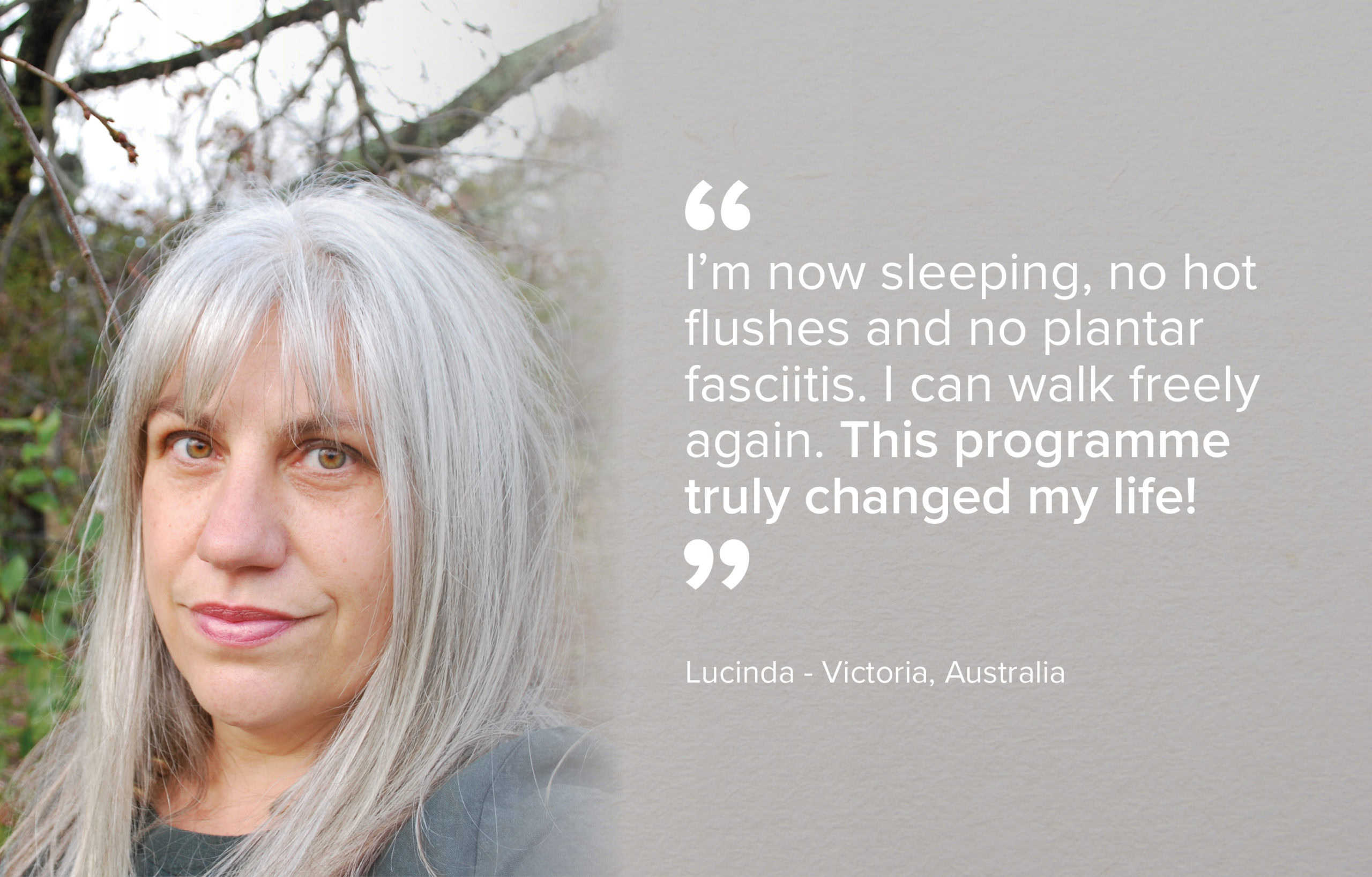
If you are feeling that your motivation is at rock bottom because you aren’t sleeping and you feel exhausted all the time, then please come and join me on either of the MyMT™programmes.
I have included the Joyful Joints module and Gut Health Restoration module and an Intermittent Fasting module in these 12 week programmes and my new Heart Health module, which has information for those of you in your post-menopause years.
There is also my progressive 6 week walking programme as well as all the scientifically evidenced lifestyle and nutrition information, which will help you to sleep all night, reduce your hot flushes and renew your energy levels so you can get your life back on track.
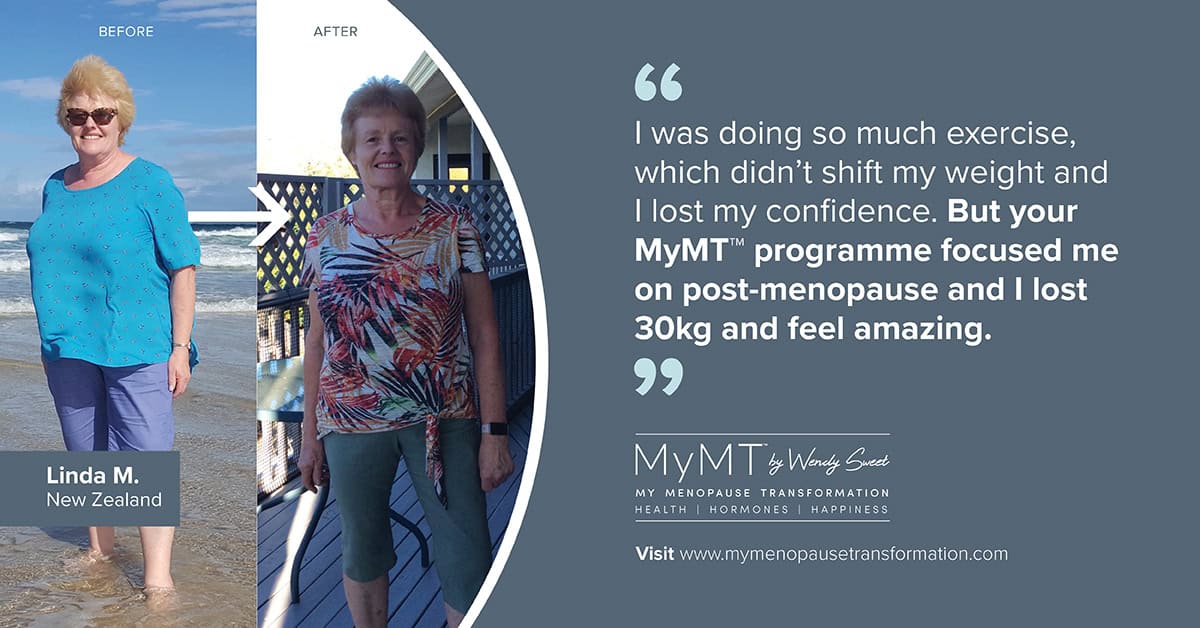
References:
Belavy, D. ,Quittner, M., Ridgers, N., Ling, Y., & Connell, D.(2017). Running exercise strengthens the intervertebral disc. Scientific Reports. 7. 45975. 10.1038/srep45975.
Collyer TA, Murray AM, Woods RL, Storey E, Chong TT, Ryan J, Orchard SG, Brodtmann A, Srikanth VK, Shah RC, Callisaya ML. Association of Dual Decline in Cognition and Gait Speed With Risk of Dementia in Older Adults. JAMA Netw Open. 2022 May 2;5(5):e2214647.
Hayes SM, Alosco ML, Forman DE. The Effects of Aerobic Exercise on Cognitive and Neural Decline in Aging and Cardiovascular Disease. Curr Geriatr Rep. 2014 Dec;3(4):282-290. doi: 10.1007/s13670-014-0101-x.
I-Min Lee, Shiroma, E.,Masamitsu K. et.al, (2019). Association of Step Volume and Intensity With All-Cause Mortality in Older Women. JAMA Intern Med. Published online May 29, 2019.
Jacka, F., Berk M. (2013). Depression, diet and exercise. Med J Aust. 16;199(S6):S21-3. doi: 10.5694/mja12.10508. PMID: 25370279.
Jakiela JT, Waugh EJ, White DK. Walk At Least 10 Minutes a Day for Adults With Knee Osteoarthritis: Recommendation for Minimal Activity During the COVID-19 Pandemic. J Rheumatol. 2021 Feb;48(2):157-159. doi: 10.3899/jrheum.200914. Epub 2020 Aug 15.
Moilanen JM, Mikkola TS, Raitanen JA, Heinonen RH, Tomas EI, Nygård CH, Luoto RM. Effect of aerobic training on menopausal symptoms–a randomized controlled trial. Menopause. 2012 Jun;19(6):691-6.
Solnit, R. (2001). Wanderlust: A history of walking. Penguin Books.
Sydora, B.C., Alvadj, T., Malley, A. et al. (2020). Walking together: women with the severe symptoms of menopause propose a platform for a walking program; outcome from focus groups. BMC Women’s Health 20, 165, 1-4. https://doi.org/10.1186/s12905-020-01037-y
Sydora BC, Turner C, Malley A, Davenport M, Yuksel N, Shandro T, Ross S. Can walking exercise programs improve health for women in menopause transition and postmenopausal? Findings from a scoping review. Menopause. 2020 Aug;27(8):952-963.
Tamariz-Ellemann A., Wickham K.A., Nørregaard L.B., Gliemann L., Hellsten Y. The time is now: Regular exercise maintains vascular health in aging women. J Physiol. 2022 Oct 27. doi: 10.1113/JP282896.
White DK, Tudor-Locke C, Felson DT, Gross KD, Niu J, Nevitt M, Lewis CE, Torner J, Neogi T. Walking to meet physical activity guidelines in knee osteoarthritis: is 10,000 steps enough? Arch Phys Med Rehabil. 2013 Apr;94(4):711-7. doi: 10.1016/j.apmr.2012.11.038. Epub 2012 Dec 7.
